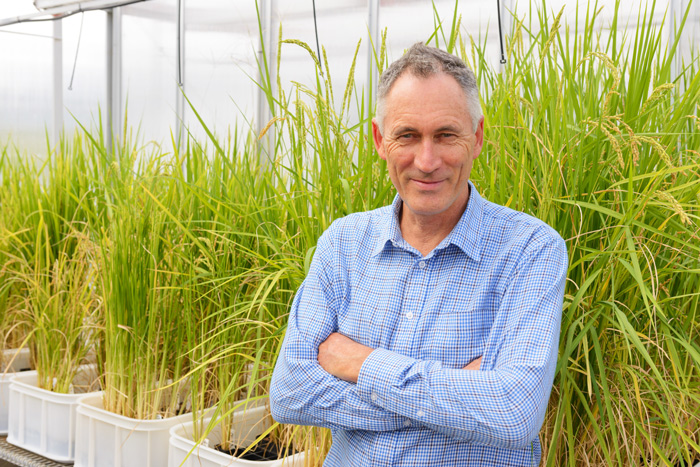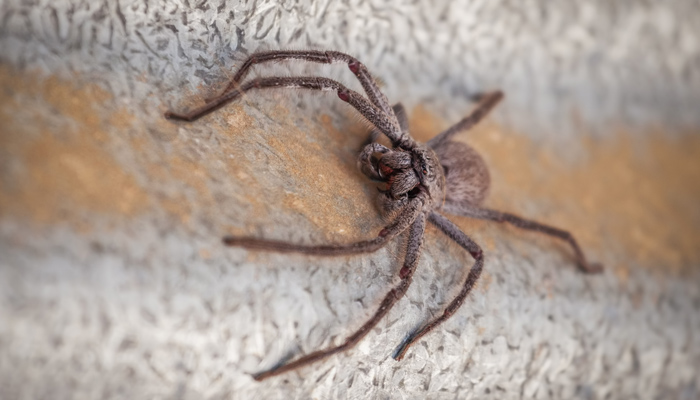
Professor Brian Atwell in the greenhouse: "We can make huge steps forward."
Macquarie University plant physiologist Professor Brian Atwell is on a mission to feed the world as it confronts a perfect storm of rising population and global warming.
In 2009, together with postgraduate student Andrew Scafaro, Atwell published his first paper revealing the discovery of a heat-tolerant protein in wild rice. The gene responsible for the protein had evolved in a rice species native to northern Australia and now, after a set of events that Atwell describes as extraordinary, the Macquarie-patented ‘wild rice’ gene is destined to be genetically engineered into the most widely grown crop in the world - wheat.
“World population growth has been so extraordinary in the past century that we really teeter in a very dangerous position and I would be happier than anybody to be able to say that there’s no radical shift in the climate happening, but there is, and it imperils not a few thousand people, but tens of millions of people,” says Atwell, who grew up on a West Australian cattle farm.
“There are cropping regions of the world which are already very hot and on the boundary of being too hot for productive cropping - Australia, India, Africa in particular, possibly parts of America, too - and there are yield penalties already in some of those places.”
Following a five-year research collaboration between Atwell’s team at Macquarie’s Department of Biological Sciences and the German bio-tech giant Bayer CropScience, Bayer will now conduct field trials with commercial wheat, having licensed the technology from Macquarie.
Experiments done in growth rooms at the Bayer labs in Belgium established that the gene from the Australian rice species Oryza australiensis conferred heat tolerance on a less heat-tolerant, commercial relative Oryza sativa. After weeks of exposure to maximum temperatures of 45°C, the grain yield of those plants with the ‘wild rice’ gene was 150 per cent greater than plants without this gene.
"The impact of this work is that we can make huge steps forward in the yield of some of the world's most important crops,” Atwell says. “It’s very exciting. A rice plant has about 20,000 genes and to add just one gene and see it do something extraordinary is very rare.”
A series of incredible events
So where did the story begin almost 10 years ago? Atwell’s initial experiments at Macquarie had shown that O. australiensis plants could grow rapidly at temperatures of 35°C and still manage to produce new leaves at 45°C when O. sativa had stopped growing. Atwell’s team used the developing strengths in proteomics (the study of proteins) at Macquarie to identify a protein that looked like it might be responsible for this heat tolerance.
Using a travel grant from Macquarie, Scafaro presented the gene sequence in Switzerland at a prestigious 2011 conference on CO2 assimilation. Bayer quickly recognised the potential of the project and joined Macquarie under a research agreement that brought considerable financial resources.
As Atwell explains, the gene doesn’t work by allowing the crop instantaneously to survive extreme heat when it otherwise wouldn’t; rather, it allows the crop to photosynthesise a little more efficiently, day by day, so that by the end of a season, it will have produced up to 150 per cent more grain than a plant without the ‘wild rice’ gene.
While the effects of the discovery will be seen commercially in wheat and not rice, Atwell is unfazed: “Where the ‘wild rice’ gene was applied isn’t a matter for us to decide; I’m just excited that it’s been applied somewhere.
“We’ve completely bypassed rice in a way and it’s almost a matter of coincidence that the gene came from a relative of rice.
“The point about wheat is that it’s vulnerable because it grows in a geographical band of the earth that is hammered by extreme temperatures and if world temperatures rise over the next 50 years by 2-6 degrees as predicted, then that will have a devastating effect on some temperate crops such as wheat.”
Next up: cotton and vegetable crops
His rice research completed, Atwell has turned his scientific attention to the general principle that Australia is a living laboratory of native plants with 'incredible' intolerance to harsh physical conditions. Many of these wild species happen to be relatives of critically important modern plants - “the plants that put cotton into clothes, and almost all the food onto our tables,” Atwell says.
Using technology developed with the assistance of Macquarie’s Australian Proteome Analysis Facility, Atwell is now looking for heat-tolerant genes in the wild Australian relatives of cotton and tobacco, the latter not for any cropping implications, but because tobacco is in the same family as key foods such as eggplant, potato, capsicum and tomato.
“We’re still in the process of untangling the very complex genetics of these plants,” he says. “Once we have the genetics sorted we’ll move forwards quite quickly, first to prove in lab experiments that the same gene we’ve always been interested in can confer heat tolerance in cotton and tobacco; and second is taking this wild version of the gene and putting it in the domestic plant and seeing if it changes its behaviour. That’s the acid test.”
Atwell can’t emphasise enough how important heat-tolerant crops are to humanity’s future – with a global population of 7 billion now and up to 11 billion by 2050, even a one per cent reduction in crop yield can result in food deprivation for tens of millions of people.
“It’s extremely serious ... I don’t think people appreciate it,” he says.
“This [the gene] was a true discovery. It was just a pie-in-the sky sort of thing, we thought maybe there’s tolerance, and all of a sudden it’s one of those strange things that with every step it didn’t fall over and we couldn’t believe it.
"It was just an extraordinary, unbelievable set of events that has led us to where we are now.”



